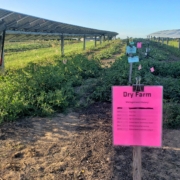Case Study: Oregon Agrivoltaic Research Facility
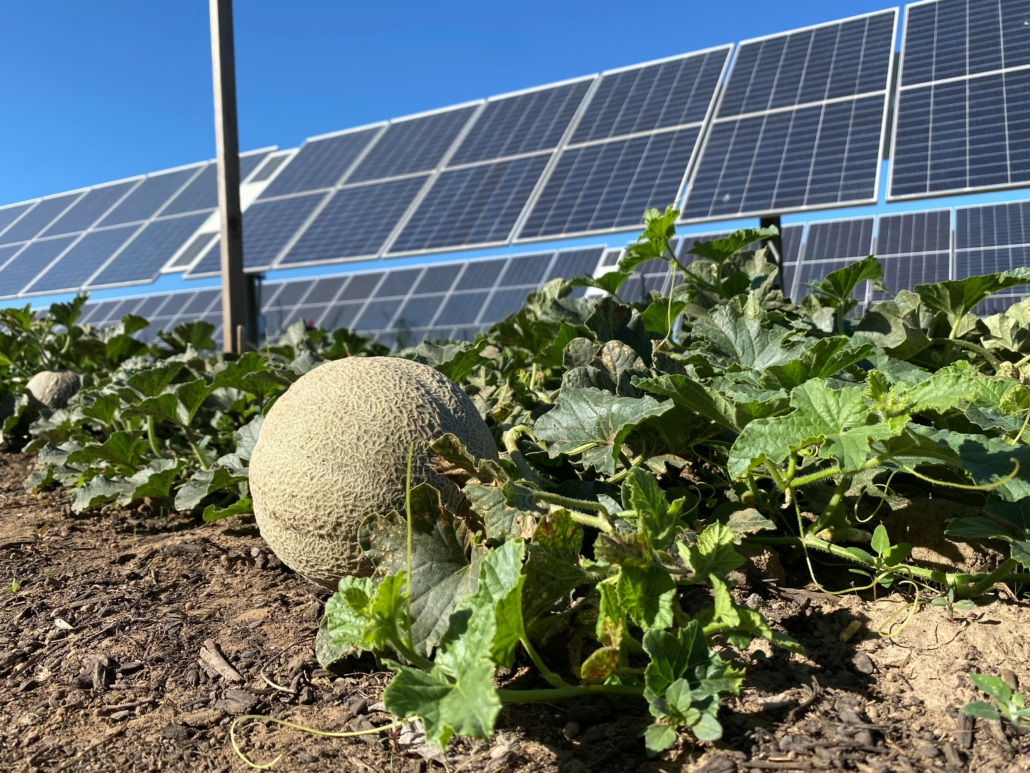
Cantaloupe melons growing between rows of solar panels.
By Anna Richmond-Mueller, NCAT Energy Analyst
B
Just south of Portland, Oregon, researchers with Oregon State University (OSU) are putting agrisolar principles to the test at the Oregon Agrivoltaic Research Facility. The site is located at the Noth Willamette Research and Extension Center (NWREC) and serves as host to OSU’s ongoing agrivoltaic research under the leadership of Dr. Chad Higgins. The numerous studies conducted on the site will contribute to advancements in multiple fields, including plant physiology, water usage, and soil health, all while producing power for Oregon citizens through a community solar program.
While agrivoltaics research has picked up in recent years, a large number of the sites being studied were not originally built with agrisolar pursuits in mind. Although it’s entirely possible to successfully integrate agricultural practices into an existing solar array, using only these sites for research lessens the opportunity to discover agrivoltaic’s full potential. With the Oregon Agrivoltaic Research Facility, Dr. Higgins and OSU flipped the narrative by instead asking: what if a solar site was designed to maximize agricultural production?
The OSU team felt it was important to approach the project from the perspective of a farmer looking to add panels into their current operations. With that goal in mind, the decision was made to design an array that wouldn’t necessitate the purchase of specialized farming equipment capable of working amongst the panels. Instead, they used NWREC’s current tractor to determine how far apart the bifacial panels needed to be spaced and chose a racking system that can tilt to a vertical position on command.
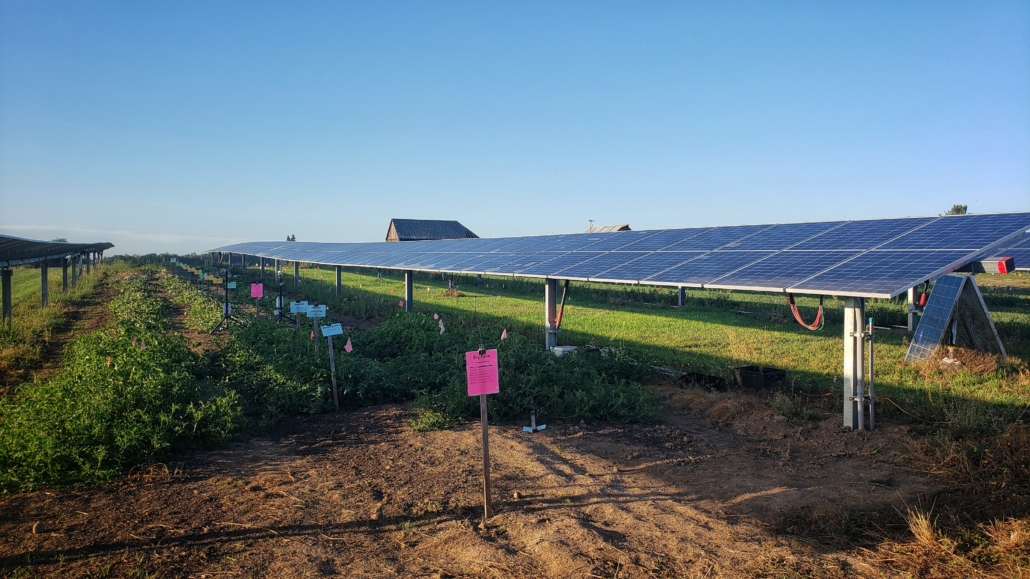
A row of dry farmed crops between solar panels.
Once again approaching the project as a farmer might, Dr. Higgins and his team chose to fund the project through loans, investors, and grants rather than having the university entirely foot the bill. The team partnered with Oregon Clean Power Cooperative (OCPC), who financed the project and maintain ownership over the site. OSU contributed about 5% of the necessary funds, and OCPC’s community investment model provided the framework for local investors to contribute as well. The project also received grants from both Portland General Electric and the Roundhouse Foundation, which provided funding for on-site NWREC staff, research, materials, and construction costs. OSU anticipates the project will pay for itself in about 10 years.
In addition to providing space for agrisolar research, the site also serves as a community solar operation with Oregon Clean Power Cooperative. OCPC was heavily involved in the project from the beginning, working with Dr. Higgins to design the system and purchase the equipment in the midst of a supply chain crisis during the pandemic. Thanks to the dedication of both parties, construction on the 5-acre, 320-kW site wrapped up in the fall of 2022, and it began producing power the following April. The site is OCPC’s first community solar project for Portland General Electric customers. Currently, OSU buys some of the power from the array, and the remaining is purchased by a local church, synagogue, and area residents, including low-income households who receive the power at a 50% discount. The partnership between OCPC and OSU has been so successful that OCPC is in the process of developing two more sites for OSU’s agrivoltaic research in the state.
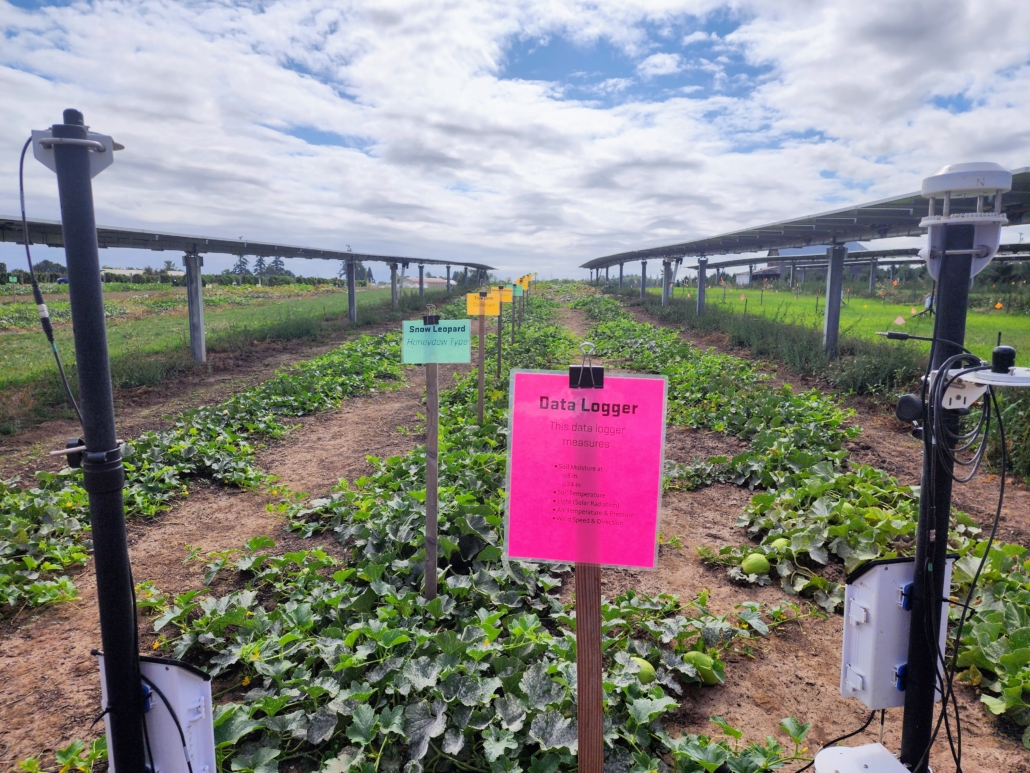
Melon crop area being monitored for detailed data collection.
Although the Oregon Agrivoltaic Research Facility is only in its first year of operation, extensive studies are already underway onsite. By the end of fall 2023, a study on soil compaction from installation will be complete, as well as an investigation into soil health in bare ground versus agrivoltaic spaces. OSU is also investing in long-term research, with a 20-year study on pollinators beginning in fall 2023. More extensive soil-quality projects will also start in the fall, looking to determine how an agrisolar system impacts soil health markers over 20 or more years. Sheep will graze on the site for part of the year, allowing for research on seasonal forage and sheep nutrition.
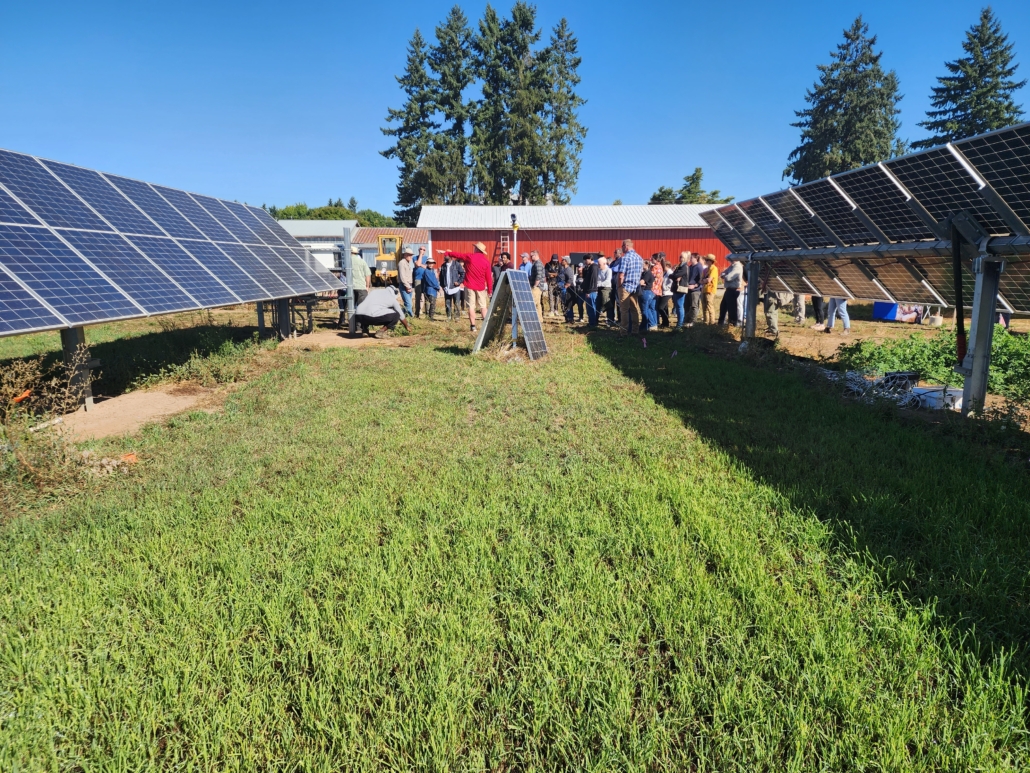
Dr. Chad Higgins and Follow the Sun tour attendees behind Argonne National Lab’s wildlife monitoring camera.
Nestled in the center of the array is a grassy row with a camera set at one end, seemingly at odds with the rows of plants surrounding it. This unassuming row is actually the location of two important studies, one focused on wildlife and the other on grass growth as a proxy for crop productivity. Argonne National Laboratory monitors the camera for wildlife that wander into the array, concentrating specifically on observing how the bird population interacts with the solar array. The grass is just one of several plots around the world included in an ongoing study by the United Nations, which is dedicated to predicting how certain crops will grow in a given environment. NWREC is home to another one of these plots, located outside of the array, and OSU team will analyze how the two onsite plots compare. This will give them insight into how a number of crops are likely to grow within the array without having to actually cultivate each plant.
In September 2023, the AgriSolar Clearinghouse’s Follow the Sun tour had the opportunity to join Dr. Higgins in Oregon and see the OSU team’s crop research in action. The researchers chose to grow their crops using a technique called “dry farming,” which relies on soil moisture and rainfall to water the plants rather than irrigation. Agrivoltaics pairs particularly well with dry farming because the shade from the solar panels significantly reduces soil moisture loss. Several varieties of squash, tomatoes, melons, hemp, and hydrangeas were successfully growing between the panels, and plans to add blueberries in the coming months were on the docket, as well. More than 75 people signed up to attend the tour and had the opportunity to listen to Dr. Higgins discuss the research facility, scalability of the project, financial considerations, and initial observations of the plants growing within the array.
The Oregon Agrivoltaic Research Facility’s commitment to embracing dual-use agriculture is truly inspiring. In addition to the research already in progress, there is an entire row of panels dedicated to experiential learning, the development of lesson plans, and opportunities for students. OSU’s clear investment in both current and future leaders in the agrisolar world leaves little doubt that the site will become a major contributor to the ever-growing body of agrivoltaic knowledge.
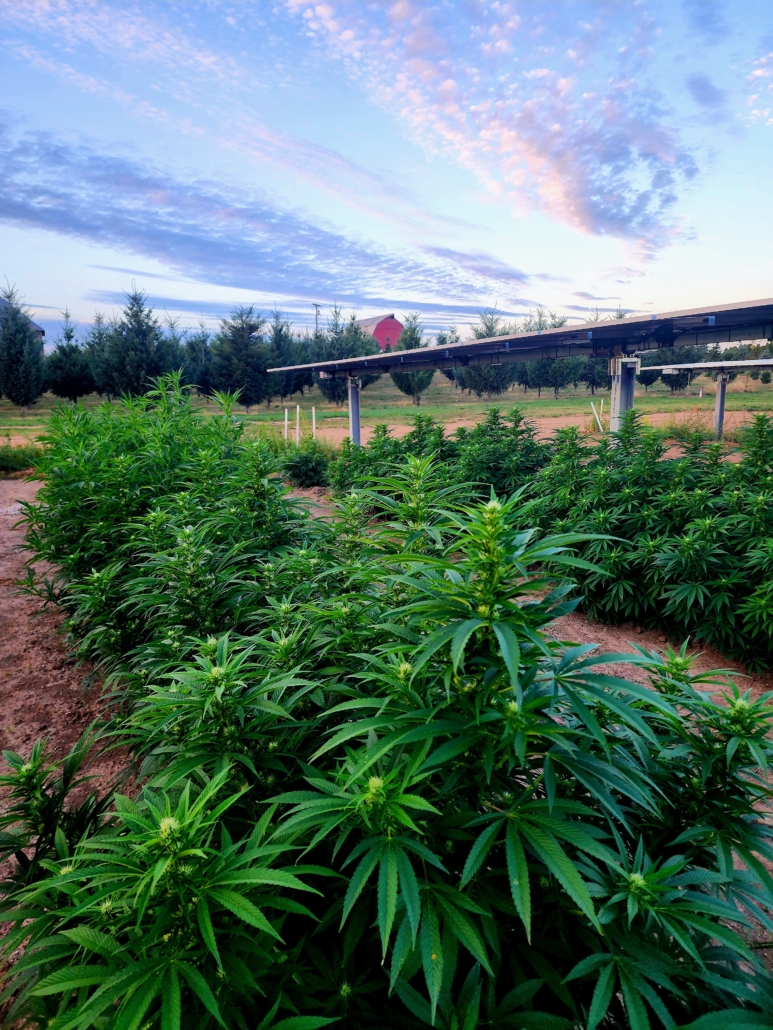
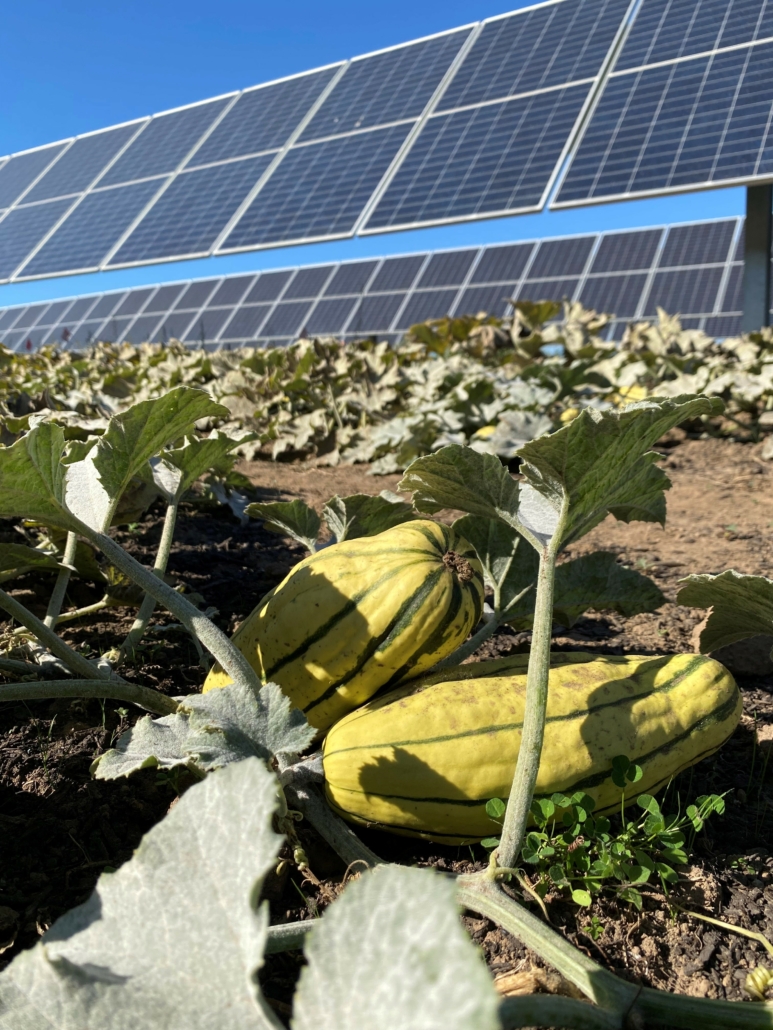
Hemp plants (left) and delicata squash (right) growing within the array.
Photo credit: NCAT
A

